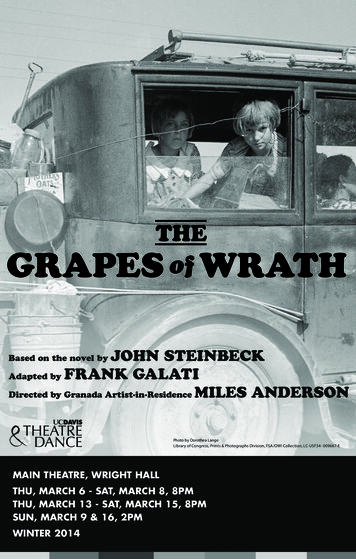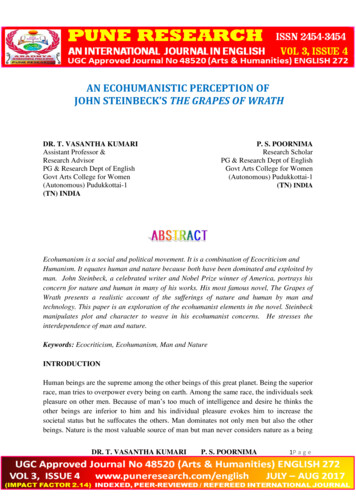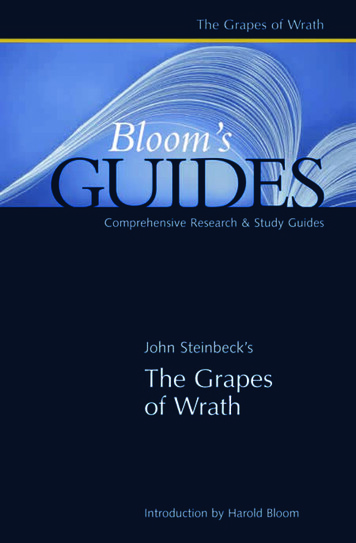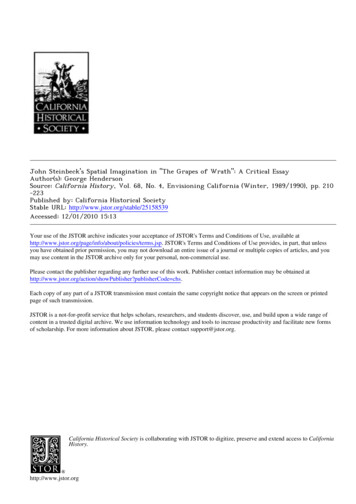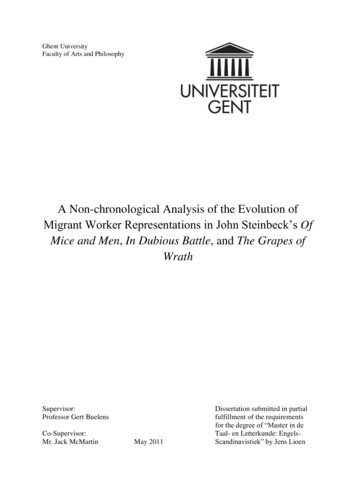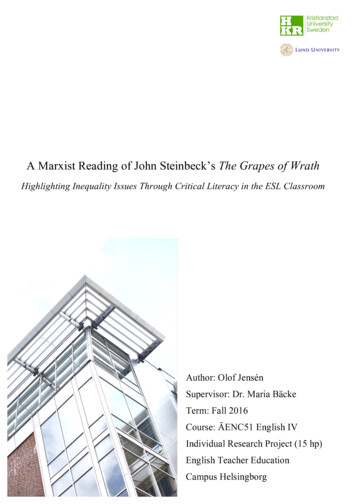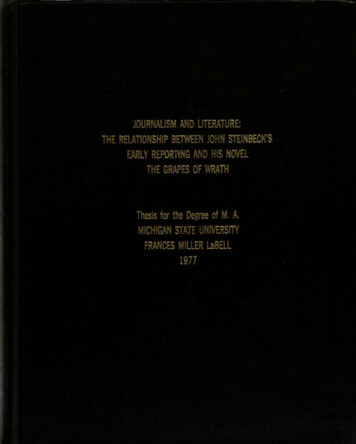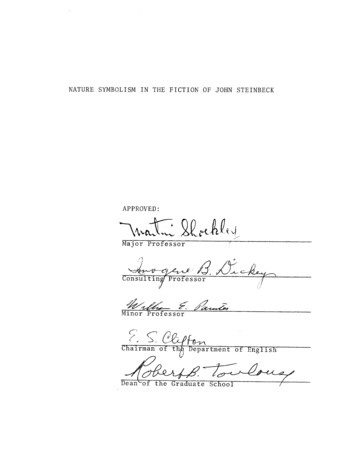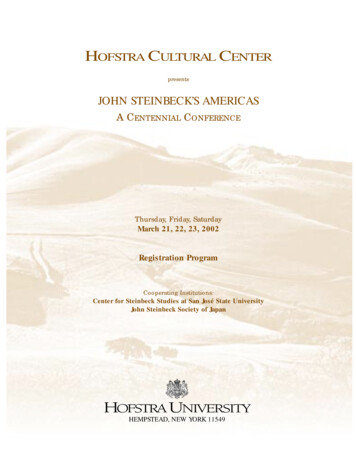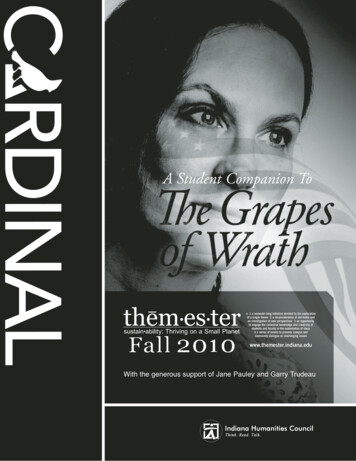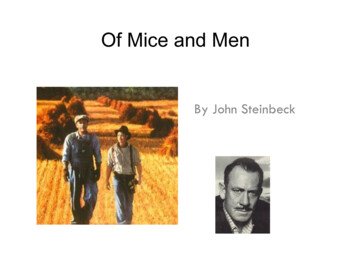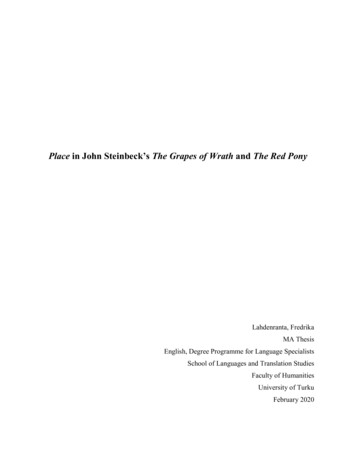
Transcription
Place in John Steinbeck’s The Grapes of Wrath and The Red PonyLahdenranta, FredrikaMA ThesisEnglish, Degree Programme for Language SpecialistsSchool of Languages and Translation StudiesFaculty of HumanitiesUniversity of TurkuFebruary 2020
The originality of this thesis has been checked in accordance with the University of Turku qualityassurance system using the Turnitin OriginalityCheck service.
THE UNIVERSITY OF TURKUSchool of Languages and Translation Studies / Faculty of HumanitiesLAHDENRANTA, FREDRIKAPlace in John Steinbeck’s The Grapes of Wrath and The Red PonyMA Thesis, 64 pp.English, Language Specialist PathFebruary --------------------This thesis examines the literary places in John Steinbeck’s The Grapes of Wrath (1939) and TheRed Pony (1933). In the thesis, I analyze how literary places, such as the ones in these twoaforementioned novels, are created. The creation of these places is divided into three maincategories: creating the place through physicality, forming it through cultural or social referencesand creating it through a personal connection or individual affect. These categories are used in theanalysis that focuses on The Grapes of Wrath.In this thesis, I argue that the use of imagery and chronotope create the physical place. In addition,the cultural and social place is created through the shifting focalization that reveals differingcultural values and significance. Furthermore, place is also envisioned through personalrelationship or attachment, for example memory and identity. These three categories are based onthe theory of analyzing place by the ecocritic Lawrence Buell. His theory and texts on environmentand place work as the basis of the analysis. The thesis also examines place attachment in The RedPony through Mikhail Bakhtin’s chronotope and Martin Heidegger’s concept of Being.The approach of the thesis is ecocritical, and its focus is also to discuss the human-naturerelationship in Steinbeck’s fiction as well as argue that examining place-centered literature canprove to be meaningful in understanding the role of humans within their environment. The thesisalso briefly examines the ideas of representing and constructing nature in relation to ecocriticismand nature writing.Keywords: place, ecocriticism, nature, narrative, chronotope, John Steinbeck
Table of Contents1 Introduction . 12 On John Steinbeck .32.1 Introducing Steinbeck, the California Native . .32.2 Steinbeck as a Nature Writer .52.3 Introduction to The Grapes of Wrath and The Red Pony . .82.4 Nature in Realist Literature . .103 Ecocritical theory and terminology . .123.1 Defining Nature, Landscape and Land . .123.2 Defining Place . .153.3. Mikhail Bakhtin’s chronotope and Martin Heidegger’s Being . .173.4 Representing ‘the Real’ in Literature .183.4.1 Understanding the non-textual through textual representation . .204 Analyzing the Place in The Grapes of Wrath .274.1 Creating a Physical place in GW .274.1.1 Imagery .284.1.2 Chronotope . .314.2. From Place defined by Physicality to Culturally Valued Landscape.354.2.1 Place-making Viewed Socio-culturally . .354.2.1.1 Cultural Significance .364.2.1.2 Economic and Capitalist Interest . .374.2.1.3 Social wellbeing .414.3 Personal Affect or Bond, and Identity . .424.3.1 Memory as a Conveyor of Place-attachment . . .434.3.2 Identity in Connection to Place . .474.3.3 Experiencing Place in the Everyday . . .515 Place-attachment in The Red Pony . .546 Conclusion .61Bibliography . . . .62Appendix: Finnish Summary .65
1 IntroductionEnvironment is not an other to us. It is not a collection of things that we encounter.Rather, it is a part of our being. It is the locus of our existence and identity. We cannotand do not exist apart from it.(Lakoff & Johnson 1999, 566)For if the entire history of landscape in the West is indeed just a mindless race towards amachine-driven universe, uncomplicated by myth, metaphor, and allegory, wheremeasurement, not memory, is the absolute arbiter of value, where our ingenuity is ourtragedy, then we are indeed trapped in the engine of our self-destruction.(Schama 1995, 14)In this thesis I examine the narrative ways place is created, portrayed and experienced in JohnSteinbeck’s The Grapes of Wrath (1939, henceforth referred to as GW). In my analysis I willexamine the different ways land, landscape and nature are used in Steinbeck’s fiction, in relationto the characters sense of identity and their connection to a specific place. What I am interested tostudy, in addition to the aforementioned, is the way nature is represented and constructed inSteinbeck’s literature. The approach of this thesis is ecocritical and I will adapt ecocriticaltheorist’s terminology and ideas. The main ecocritical theorist whose ideas I will use to guide myanalysis is Lawrence Buell. I will also use Mikhail Bakhtin’s concept of chronotope to discusshow the literary form connects with nature. In addition, I will examine place-attachment in TheRed Pony (1937, henceforth referred to as RP). In addition, in order to understand this form ofplace-attachment, I will adapt Martin Heidegger’s concept of Being. My main statements are:1) The sense of place is created through physical, cultural and emotional descriptions ofplace. In affect, place is formed through the concepts of land, landscape and nature. Theuse of the chronotope builds the sense of place and adds a fourth dimension to place in thenovel.2) Nature is represented, not constructed, in GW. The distinction between representationand construction of environment stems from the division between nature and culture, whichis questioned in GW by portraying human characters as a part of the natural realm.3) The characters connection to their place and environment in RP is portrayed throughplace-attachment, and the use of chronotope supports their attachment.1
The way land, landscape and nature are intertwined in the characters experiences, lives andidentities in Steinbeck’s novels is what first drew me in to the topic of this thesis. The intricaciesof feeling attached to a certain place are narrated in such simple yet multifaceted ways that the actof reading these places created in Steinbeck’s literature makes one awaken to their ownsurroundings as well. Furthermore, being able to relate to a story of a novel written in the 1930sUnited States of America describes the timelessness and universality of the topic. The connectionto the environment is at the same time a global and a local matter, and extremely important,whether we distance ourselves from it or not. Human culture is dependent on the environment andon nature, and despite of the steady progress of technological advancements and modern culture,the separation from our physical environment is impossible.The place, which is formed of land, landscape and nature, cannot be categorized only as asetting. The environment in the GW exists on its own terms and has agency that evades the role ofa typical literary setting or a background location, but works as a vivid, phenomenal existence thatsurrounds the characters and forms a place in its own right. It is equally important to note that theplace provides a home, a place to belong to, and a place to link memories to. I will first introducethe terminology and theory and then move on to analyzing GW and RP in the light of these theories.My focus is to argue that the representations of and the references to land, landscape andnature are included in the creation of a literary place. I will focus on portraying the textual worldcreated by the narrator in Steinbeck’s GW but I will also mention its references the actual ‘real’(non-textual) life place as much as it is necessary. In addition to this, I will discuss the concept ofnature and examine whether it is constructed or represented through the texts of ecocriticsLawrence Buell and Dana Phillips. I question the concept of nature throughout the thesis andprovide an ecocritical insight in examining places as part of nature. Furthermore, I claim thathumans are a part of Steinbeck’s understanding of nature. In Chapter 2, I will briefly introduce theauthor and the two novels of my focus and then define the theory I use in more detail.2
2 On John SteinbeckIn this chapter I discuss the author John Steinbeck to the amount that is necessary in order tointroduce the effect of place connectedness in literary works. Although Steinbeck as a writer is notthe main focus of this thesis, I will briefly introduce his character in relation to California, as Iconsider his background and his connectedness to his home region relevant to the content matterof the thesis. My focus is on understanding his character as a place-centered author as a native ofCalifornia, the location he most often wrote about.2.1 Introducing John Steinbeck, the California NativeSteinbeck’s home region proved to be an infinite source of inspiration for the novels that definedhim as a writer: “As a region [California ] contains such polar extremes as the hard materialismof Salinas and the bohemianism of the Peninsula. Both have obviously been important inSteinbeck’s writing, but Salinas came first and is most apparent” (Champney 1972, 21). As thisquote shows, as a California native Steinbeck wrote mainly about his own home state. He grew upin California that, as a location, is well known for readers of Steinbeck from several novelsincluding GW, RP, and East of Eden (where the reader is briefly faced with young John Steinbeckhimself).California, through Steinbeck, is a place of hope and possibilities as well as a location thatis torn apart by its contrasting features; the beautiful land is often overworked and not open foroutsiders, be they tourists (GW and Travels with Charley), migrants (GW), unemployed people(GW, Cannery Row, Sweet Thursday) or working class agitators (GW, In Dubious Battle). Inaddition to that Champney (1972, 26) writes that “Steinbeck’s California contains little fragmentsof the American character, detached from the whole and dragged over the mountains and the desertwith the other immigrant baggage and overdeveloped by the golden sun and the ache ofhomesickness.” This element is also present in several of Steinbeck’s texts. His works oftendiscuss many of the aforementioned social issues, delving into the personal psyche of the peoplein certain social classes. An important note to understand about the works of Steinbeck is that heexamines his subjects often from a certain distance, although often basing his examination withinhis own home state of California. He offers his own ideas by emphasizing the importance of3
communal spirit and supporting one another, especially in relation to working class groups (e.g. innovels such as In Dubious Battle and Cannery Row, which both discuss lower class groups of men,the former mainly from a political point of view) but without underestimating the reader’s ownability to come to a certain end result. Some critics argue that Steinbeck’s writing had an agenda:“Steinbeck’s writing stood not just as a protest, but as a call for social reform” (Jakle & Sculle2011, 22).Many of Steinbeck’s novels derive their inspiration from California, and from theconditions of the land, as Champney explains: “[M]ore perhaps than any important contemporaryAmerican writer, except William Faulkner, his writing has grown out of a special region”(Champney 1972, 21). He continues to analyze the specific meaning of the California environmenton Steinbeck’s fiction: “The cultural climate of the Salinas Valley is typical of Californiaagriculture. A tradition of personal individualism goes along with a strongly collectivizedeconomy” (ibid.). With this Champney showcases the uniqueness of the Salinas cultural landscapewhilst also underlining its function as an example of the statewide culture. The California regionthat is now also known as “Steinbeck Country” offered several ideas for writing for the aspiringauthor, as it was, and perhaps still is a “economically, socially, and culturally [ ] an ugly state ofaffairs” (ibid.) and at the same time a land of natural grandeur and beauty, filled with farms,orchards and fields as well as rivers, valleys, mountain ranges and specific coastal region. Forexample, the idea for GW came from direct experience; as a California resident Steinbeck hadwitnessed the effect of the Dust Bowl on his home state. This made him so interested that hefollowed the migrants from Oklahoma back to California, lived on camps and picked cotton (Lisca1972, 75). In addition, Brian Railsback writes about Steinbeck’s involvement in the matters hewrote about, and his consistent aim for realism: “Serious research for Grapes of Wrath began withSteinbeck’s San Francisco News assignment to write a series of articles about migrant farm laborin California, which required observing conditions at various labor camps” (2013, 218).Steinbeck was, thus, involved with not only the political, cultural and ecological changesof his own state, but also his own country. This connection that Steinbeck shared with his homestate is also transferred onto the readers through his writing, according to author Melody Graulich.She writes about the connection that she shared with the land of California: “Steinbeck’srepresentation of the landscapes we knew and treasured allowed us to read with a personalrecognition and understanding” (Graulich 2007, 37). Finding something as personal as a4
connection to one’s home region in a text allows one to understand the region in a different lightand with a certain depth that might not be achieved through a non-locals writing. This does notmean that one has to be a California native to understand Steinbeck, quite the contrary. Readingplace connected and place focused literature can offer a structure or a model through which onecan find a meaningful connection to their own local places or allow them to better understandCalifornia as a place.Therefore, Steinbeck’s own personal relationship and connection with his native Californiaproves to be an essential source for his realist although often ideological writing (Champney 1972,29). Although I am not focusing on Steinbeck as an author behind the narration, I consider hisconnection with his land an important aspect that deserves to be acknowledged when consideringplace-centered writing, especially when understanding it from an ecocritical perspective.2.2 Reading John Steinbeck as a Nature WriterJohn Steinbeck has not commonly been considered as a nature writer. He is best known for hispolitical commentary in several novels such as GW, In Dubious Battle and Of Mice and Men.Steinbeck’s writing often focuses on social injustice and societies or groups within politicalturmoil. Examining Steinbeck’s writing with the focus on nature opens up another aspect ofSteinbeck that I claim has not received enough attention. Several of Steinbeck’s novels are focusedon the connection between humans and their environment. Railsback comments that “Steinbeckwrote his best work from an environmental perspective before the word ‘ecocriticism’ was coined”(Railsback 2013, 217). Being and existing within the natural world is a recurring theme in theSteinbeckian fiction. The landscape and the physicality of it is at the same time a concrete thingthat provides sensory satisfaction and a deep physical connection to nature and the world around,as well as a mystified, distant realm of nostalgia and longing. In order to explore Steinbeck as anature writer I first define what is nature writing.Nature writing is usually defined along the terms of “literary nonfiction that offersscientific scrutiny of the world [ ], explores the private experience of the individual humanobserver of the world, or reflects upon the political and philosophical implications of therelationships among human beings and the larger planet” (Slovic in Buell 2005, 144). Thisdefinition describes Steinbeck’s fiction well. Although Steinbeck is most often remembered as a5
political writer, some scholars consider him as an “ecologically minded fiction writer” (Railsback2013, 216). Steinbeck reflects on “the political and philosophical implications” (ibid.) anddiscusses the relations that humans have with their environment, although perhaps not as explicitlyas some other writers, e.g. Henry David Thoreau or Leslie Marmon Silko. In GW and RP, inaddition to novels such as In Dubious Battle and Cannery Row, Steinbeck delves into moral issuesrelating to human relations with their environment.Furthermore, I claim that Steinbeck’s fiction can be beneficial for understanding humansand their connection with their environment through analyzing the novels through place. Forexample, GW provides a form, a structure to understanding the climate crisis, climate refugees andland use patterns. Christopher Salter writes about GW “as providing focus for instruction inmigration, settlement forms, economic systems, cultural dualism, agricultural land use patterns”(Salter in Buell 1981, 156–57). Similarly, Karen E. Waldron and Rob Friedman suggest thatstudying literary places reveals human relationship to their environment:We argue that all literature has and reflects place, humans as well as environments inrelation to each other, and that the material referenced in literary texts therefore alwaysincludes, as Lawrence Buell has insistently argued, nature and culture, the biotic and thebody, the entire matter of the world, in some form that can be read through representationsof place. (2013, ix; emphasis original)In this sense, understanding place and place attachment in literary texts allows the reader toexamine the real world and one’s own role as well as the communal position humans have withintheir ecological surroundings.In fact, by discussing the political problems that arise from exploiting the people, Steinbeckalso questions the relationship between humans and their environment. In GW, the narratorcondemns the actions of the California fruit farmers and underlines the arbitrary ridiculousness ofowning land and exploiting its resources. This following quote exemplifies the distortedrelationship with their environment as well as their fellow countrymen a person can have: “Thefertile earth, the straight tree rows, the sturdy trunks, and the ripe fruit. And children dying ofpellagra must die because a profit cannot be taken from an orange” (GW 385). This image of theunfortunate tragedy is a heavy statement against the immoral actions of the California fruit farmers.The narrator continues: “And coroners must fill in the certificate -- died of malnutrition – becausethe food must rot, must be forced to rot” (GW 385). By viewing the environment as a source for6
profit, the farmers fail to understand the absolute connectedness humans have with theirenvironment.Furthermore, reading literary texts from decades ago (i.e. the 1930s), that focus on placesand environments that differ greatly from the reader’s current spatial and temporal existence (suchas California’s Salinas Valley, a specific bioregion with native wildlife and fauna, or the GreatPlains’ specific weather patterns and climate) can support the attempt to understand the samepatterns that make our current place and space what it is, or what it appears to be.In addition to this environment-focused aspect, Steinbeck maps out the process of a manalongside nature and delves into the ways humans interact with their surroundings. I use the wordman in this context to mean the whole of mankind, but I acknowledge the fact that the ideaSteinbeck’s fiction express of mankind is a very masculine one. Examining the masculinity andomission of the active female counterpart would be an intriguing matter to study, although to mycurrent topic irrelevant due to my focus. Instead of appreciating and admiring nature from a certainintellectual distance, Steinbeck writes from within nature, from the point of view of a man, who isinvested in the land, claims ownership of the land and abuses the land but has no other way ofexisting except within and in deep connection with the land. This quote from Steinbeck’s 1932journal exemplifies his holistic perception: “The trees the muscled mountains are the world—butnot the world apart from man—the world and man—the one inseparable unit man and hisenvironment. Why they should ever have been understood as being separate I do not know”(Steinbeck in Shillinglaw 1994, 9). As the quote exemplifies, Steinbeck’s style of writing natureis at the same time realistic and ideological.As a writer Steinbeck delves into the everyday of man within nature, without distancingthe nature into something that is “out there.” In Steinbeck’s fiction nature is “here.” It is presentall around, as the soil under the characters feet and as the dust on their hands. The characters liveand breathe the land and are constantly affected by it, by the changes and the instability of natureand land. Steinbeck’s fiction offers a realistic and holistic idea of nature instead of an ideal image,to the extent that is possible in literary form. Disregarding the emphasis of land, landscape andnature in Steinbeck’s fiction would mean leaving out an important part of what makes Steinbecka sharp commentator of the world. Therefore, I have chosen my topic as something that will reveala previously largely disregarded side of Steinbeck’s fiction.7
One aim of my thesis is to show how Steinbeck underlines that humans are a part of nature.In his fiction, Steinbeck includes human existence in the world within the natural by narratinghuman existence within nature’s existence. By using narrative ways such as descriptive languageto suggest that humans are in deep coexistence with the non-human world, Steinbeck portrays hisunderstanding of human’s role in the world. Despite the distinction between man-made cultureand wild non-human nature that is evident in Steinbeck’s writing, man is, at the same time, aphysically inseparable part of nature.2.3 Introduction to The Grapes of Wrath and The Red PonyIn this section I will briefly introduce the two novels by Steinbeck that I am going to analyze: TheGrapes of Wrath and The Red Pony. Critic Robert Murray Davis writes about the form of GW andcomments that “structural patterns in Steinbeck’s novels are clear, they are almost blindinglyobvious: the Exodus analogy in The Grapes of Wrath, combined with interchapters whose functionis always quite clear” (1972, 4). At the time of its publishing, the novel “did not have a chance ofbeing accepted and evaluated as a piece of fiction” whilst causing a “social-political-economiccontroversy” (Lisca 1972, 79). Despite the aforementioned, the role of GW in the American literaryhistory as well as political realist fiction is secure, which also sets challenges to examining it.The plot of GW is a relatively straightforward. The novel begins with a long description ofthe land, providing the reader a clear image of what is happening in Oklahoma of the 1930s. TomJoad, one of the main characters, is released from prison and finds his family as they prepare toleave their home in Sallisaw, Oklahoma. The family is forced to leave their home due to theworsening environmental condition, which makes the banks that own the land, evict the tenantswho farm on the poor, over-cultivated land. The novel follows the family’s arduous journey,commenting on the political situation of the land, the effects it has on the people, places and thewhole nation. The family of the Joads is used to represent the wider community of migrant workersand is discussed side by side with the nameless group of the ‘Okies’ in the interchapters. Theinterchapters connect the individual family’s experience to the nationwide struggle. EcocriticLawrence Buell summarizes GW’s political plotline as follows: “Ironically, the Okies undertooktheir hazardous odysseys only to find a more ruthless agribusiness establishment than the one thatdispossessed them” (Buell 2014, 163). The conditions that the ‘Okies’ (derogatory term for the8
migrant workers) escape are only the start for their struggle, as life in California is not asuncomplicated as they are led to believe.The novel’s main characters are Tom and Ma Joad, and the former preacher Jim Casy. Outof these three characters, Tom Joad represents the collective power that humans have when theywork together, as his famous monologue at the end of the novel reveals:Wherever there is a fight so hungry people can eat, I’ll be there. Wherever there is a copbeatin’ up a guy, I’ll be there . I’ll be in the way kids laugh when they’re hungry andthey know supper’s ready. An’ when our folk eat the stuff they raise an’ live in the housesthey build—why, I’ll be there. (GW 463)Similarly, the former preacher Casy functions as a character who provides a valuable insight to theway nature and humans are understood as one spiritual entity: “all that lives is holy” (GW 157). Inaddition to Tom and Casy, the head of the 11-person family, Ma Joad becomes a meaningfulcharacter in the course of the novel. She is a provider of temporal knowledge, of family history inrelation to places. She also provides a feminine perspective, as a caretaker who bears the mentalload in the family’s migration from one place to another. These three are the main characters whoseperspectives are narrated through focalization.In contrast to GW, Steinbeck’s early novel RP (1933) did not cause a similar uproar as theGW due to its non-political focus, but is mainly considered as young adults’, or children’s fiction.The novel tells the story of a young boy, Jody, living on a farm near Salinas, California. The novelis divided in four sections: the Gift, the Great Mountains, the Promise and the Leader of the People.These sections structure the novel by focusing on a meaningful event to Jody, one at a time. In thefirst section, Jody receives a red colt, which unfortunately later on dies, as a present from his father.In the second section Jody is faced with a man who steals his father old horse to ride to the distantand mysterious mountains. The third section refers to a promise that the farm hand Billy Buckmakes to Jody about a new colt, and the last section introduces a previous generation's perspectiveon the landscape through Jody’s grandfather, who shares stories about ‘Westering’. The noveltherefore follows the young boy as he navigates through early adolescence and attempts to find hisown place in relation to his parents, grandfather and his surroundings e.g. the mountains, whichbecome an important factor for his personal growth. Furthermore, the pony represents freedom9
and responsibility, and for a while forms a center that Jody’s life revolves around. In the followingsection, I discuss the functions of nature in realistic literature.2.4 Nature in Realist LiteratureIn this section I will briefly introduce the ways nature and landscapes have been represented inliterature and what functions nature has served in literary writing. My focus is on realist andnaturalist writing because these are the literary movements Steinbeck’s writing is most oftenconsidered to be a part of. Waldron writes that in the naturalist/realist period writing focused onespecially “the complex ecology of the human/nature connection in places and spaces” (2013,xvii; emphasis original). She underlines the importance of examining places in more depth thanmerely a background for the main action: “That complex ecology is critical for literary study [ ]:mere discussion of setting barely scratches the surface of what literary works portray and wrestlewith when depicting the nature of places” (ibid.).Delving deeper into the literary places allows us to better understand the interconnectedmeaning of the characters situated existence in their environment. The meaning of nature in theabove quote “is dual, even multiple” because it “describes both physical surroundings andcharacter, a force that is other and a force within” (ibid.) whilst reminding us that these two are“impacting [each] other in ways we constantly try to understand and categorize but will neverknow or be able to name completely” (ibid.). This description outlines the multifaceted role ofnature. To understand the role of places and nature (these can be understood in several differentways, for example nature in building a place or nature as a place) one is required to understand theways nature and places have been understood previously in literature, and what are the factors thataffect these understandings. Furthermore, to truly understand the meaning of place (or nature)focused reading, one must attain knowledge of the benefits that nature/place-focused reading mightobtain. I continue to explain not only how nature is perceived in literature and how it takes part increating places, but I will also convey the benefits of reading literary texts with nature, place orecocritical focus in mind.When discussed in literary texts, the natural world is often simplified into two differingcategories, as either “a place of idyllic simplicity, of ‘harmony’ with nature, or of hard scrabblingagainst natural forces” (Waldron 2013, xxii). Within the naturalist and realist periods, nature was10
use
Place in John Steinbeck’s The Grapes of Wrath and The Red Pony MA Thesis, 64 pp. English, Language Specialist Path February 2020 ----- This thesis examines the literary places in John Steinbeck’s The Grapes of Wrath (1939) and The Red Pony (1933). In the thesis, I a
